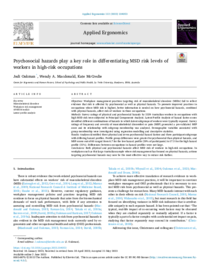Psychosocial hazards play a key role in differentiating MSD risk levels of workers in high-risk occupations

Oakman, Jodi ; Macdonald, Wendy ; McCredie, Kate
2023
112
104053
musculoskeletal diseases ; psychosocial risks ; risk assessment
Psychosocial risks
https://doi.org/10.1016/j.apergo.2023.104053
English
Bibliogr.
"Objectives
Workplace management practices targeting risk of musculoskeletal disorders (MSDs) fail to reflect evidence that risk is affected by psychosocial as well as physical hazards. To promote improved practices in occupations where MSD risk is highest, better information is needed on how psychosocial hazards, combined with physical hazards, affect risk of workers in these occupations.
Methods
Survey ratings of physical and psychosocial hazards by 2329 Australian workers in occupations with high MSD risk were subjected to Principal Components Analysis. Latent Profile Analysis of hazard factor scores identified different combinations of hazards to which latent subgroups of workers were typically exposed. Survey ratings of frequency and severity of musculoskeletal discomfort or pain (MSP) generated a pre-validated MSP score and its relationship with subgroup membership was analysed. Demographic variables associated with group membership were investigated using regression modelling and descriptive statistics.
Results
Analyses identified three physical and seven psychosocial hazard factors and three participant subgroups with differing hazard profiles. Profile group differences were greater for psychosocial than physical hazards, and MSP scores out of 60 ranged from 6.7 for the low hazard profile (29% of participants) to 17.5 for the high hazard profile (21%). Differences between occupations in hazard profiles were not large.
Conclusions
Both physical and psychosocial hazards affect MSD risk of workers in high-risk occupations. In workplaces such as this large Australian sample where risk management has focused on physical hazards, actions targeting psychosocial hazards may now be the most effective way to reduce risk further."
Digital
The ETUI is co-funded by the European Union. Views and opinions expressed are however those of the author(s) only and do not necessarily reflect those of the European Union or the ETUI.